We toured this impressive facility today, along with an older fish
hatchery located nearby.
Both hatcheries are built along aptly-named
Fish Creek and both are on or adjacent to Joint Base
Elmendorf-Richardson (JBER) property. The older Fort Richardson State
Fish Hatchery is gradually being phased into the newer Hernandez
facility at Elmendorf AFB but is still open to visitors.
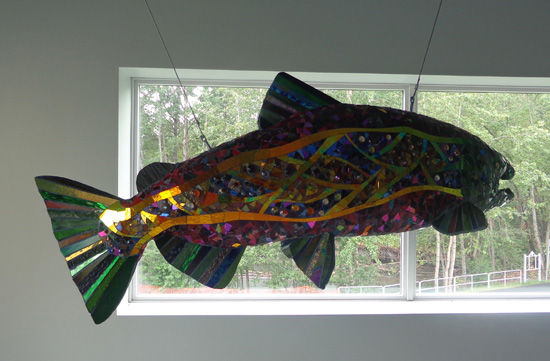
One of three decorative fish mosaics hanging from the ceiling
in the new fish hatchery
I'll give you a little tour of both hatchery facilities in this entry,
as well as show photos of some more aircraft on display at Elmendorf AFB
-- and, surprisingly, two exquisite bald eagles that are being
rehabilitated in a nice enclosure right across from the aircraft
display.
And I'll show you how salmon, eagles, and aircraft relate to one
another . . . but first, a weather report.
RAIN AND "ENDLESS WINTER"
We
had a great run of sunshine for the last six days, which apparently is
unusual in Anchorage in July. We tried to make the best of that by being
outside a lot. Last night and today we had a 90% chance of rain so we
planned our activities accordingly.
Per the local news, it has still been the second-coolest July
on record in Anchorage and the chilliest since 1920. Here’s a
link re: the city’s chilly
summer and record-breaking snow levels during the winter. Locals feel
like it's been an endless winter, at least in the mountains.
We know how to pick which summer to visit Alaska, eh?? We're having a
great time anyway.
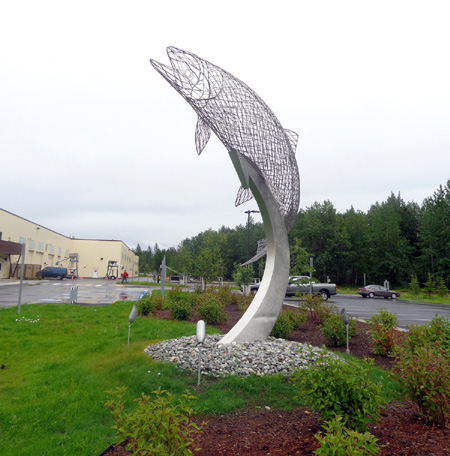
Fish sculpture at the entrance to the new fish
hatchery; fish don't care if it's raining.
We woke up this morning not knowing if we’d have to move to a different
camping spot today.
Folks are limited to two weeks at the Black Spruce FamCamp at JBER unless
there are available spots after 1 PM on the day
they are supposed to leave. (We can't make reservations here --
it's first come, first served.) Our two weeks were up this morning
and the campground was still pretty full last night.
Worst case, we'd have to move to a "dry" camping site with no hookups.
It’s somewhat of a pain to move a 5th-wheel coach. It's
more of a pain to move to a dry (AKA boondocking) camping site on a rainy day
after we've been spoiled with full hookups the last two weeks.
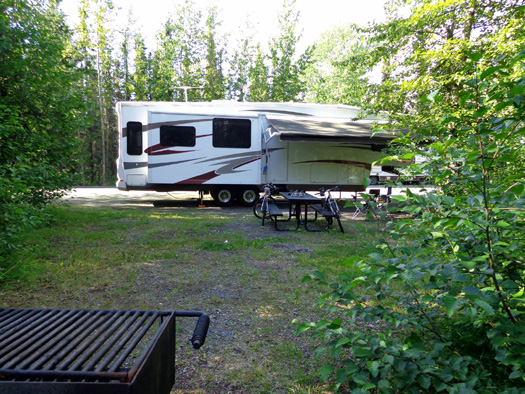
Fortunately, we didn't have to wait until 1 PM to find
out whether we could stay put. The campground host let us know by
9:30 AM that we can stay in our current site a few more days because
enough other folks are leaving today.
Whew! That worked out well for us. We were free to leave and do what we
wanted to do today. And with lots of rain predicted for the
coming week we'd rather stay here than head up the road toward Denali
National Park earlier. We may spend some time at Denali State
Park first, and we won't have hookups there.
FORT RICHARDSON STATE FISH HATCHERY
While we were out running errands we toured the two fish hatcheries
mentioned above.
Both hatcheries are on Fish Creek, which runs the length of JBER. They are
managed by the state Fish & Game Department. Although the fisheries are
marked on our base map we didn’t notice them until I read about them in
one of the visitors' guides I picked up.
We toured the
Fort Richardson hatchery first. This
older facility is off Grady Hwy. just a couple miles from our campground.
We spent about 30 minutes looking around the outdoor fish raceways. One
of the fish culturists, Chuck, was hand feeding a large tank of Arctic
char. They were divided into three groups, based on age. The four-year-olds
will spawn this fall, the three-year-olds next fall, and the two-year-olds in
2014.
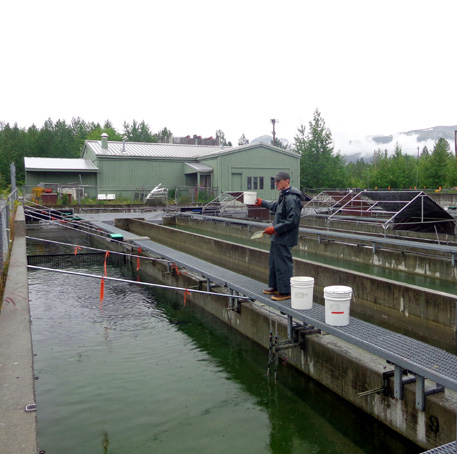
The fish are usually fed automatically but Chuck had just come back
after being gone for a week and he wanted to see how the char were
eating. He gives them nutrient-dense food so they’ll grow larger.
The water in the tanks used to be warmer when there was a power plant
nearby (the reason the hatchery was originally located on base). Now the
water stays pretty cool all year long (33-42 F.) and the fish don’t grow
as large as they did in warmer water. We asked lots of questions and
Chuck readily gave us all kinds of interesting information.
He encouraged us to wait until he was done feeding the char so we could
watch him feed the rainbow trout. The char stayed under water as Chuck
tossed small batches of food pellets (looked like dog food) into their
tanks. The trout were much more active and jumped around when he fed
them.
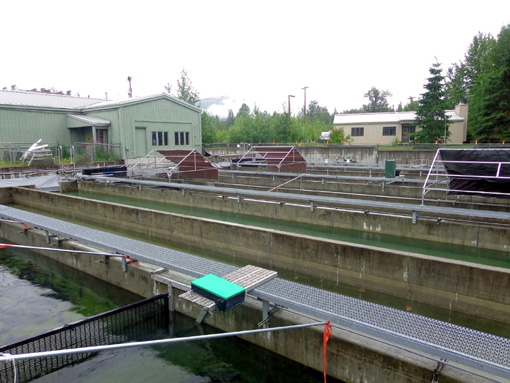
Because a bald eagle tried to get into the trout tank, Chuck came up
with two strategies to discourage it. He strung wire with flagging on
it a foot above the chain link fence the eagle wanted to sit on and he
placed plastic tubing across the tank every 20 feet so the eagle can’t
swoop down from the air to get to the fish.
Jim mentioned that we’ve been to the fish hatchery in Leadville, CO
several times. Chuck, who has been in the business 24 years, knows all
about that prominent national fish hatchery.
Chuck works out of the new facility just outside the Post Road gate at
Reeves Blvd. We
went over there next and did a self-tour through the very large
building. The old hatchery will eventually be phased out and merged with
the new one, which was built just last summer.
THE WILLIAM J. HERNANDEZ SPORT FISH HATCHERY
This place is impressive for many reasons.
Not only is it state of the art for fish production and resource
conservation, it is also laid out well for visitors to take tours by
themselves through wide corridors overlooking the tanks and other
equipment. You can also walk along the creek bank to see spawning fish
and the outdoor raceways.
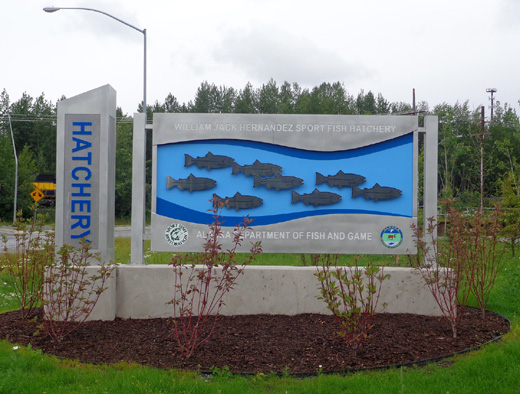
Visitors start their tour upstairs near the parking lot. All the large
and small tanks and other operations are on the first floor.
We walked through the hallway upstairs and could look down through large
windows to see the tanks, pipes, etc.:
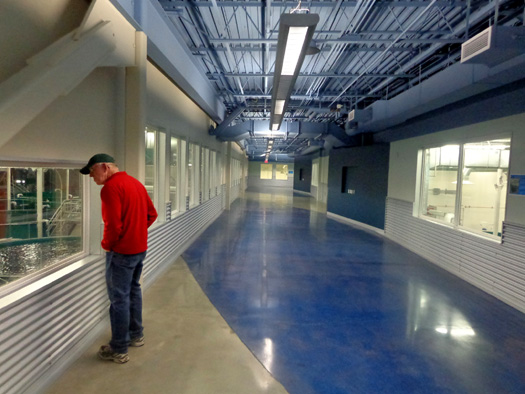
Numerous interpretive
signs describe the equipment and operations:
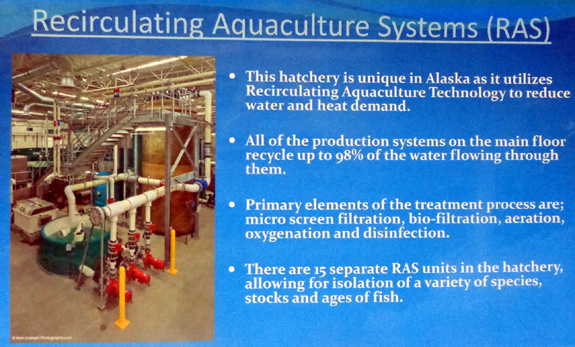
We were very impressed with both the scope/design of the facility and
the appealing way it educates visitors.
You can read more about it
here and
see a diagram of the layout.
These 26 large
fiberglass production tanks each hold over 23,000 gallons of water and
can house up to 27,000 eight-inch-long rainbow trout or 240,000 Chinook
or coho salmon:
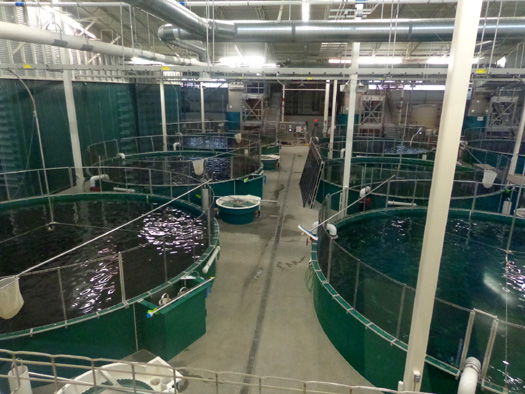
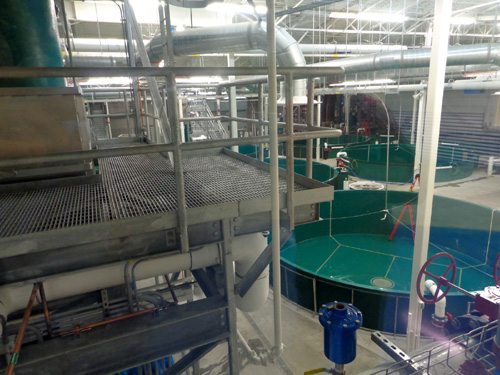
Thirty-two smaller tanks in the start-up rearing area can hold a total
of three million young salmon and trout at one time:
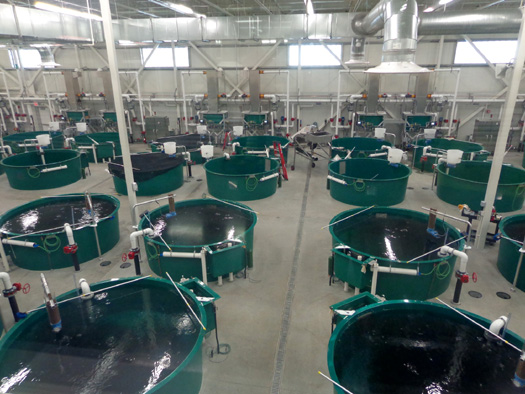
Another start-up area is specifically designed for young Arctic grayling and
char, as well as rainbow trout brood stock. These species have special
dietary needs:
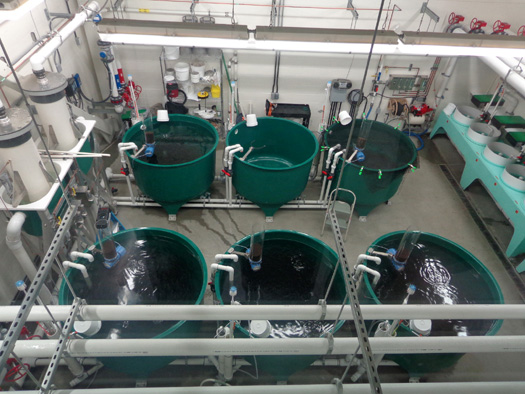
There is an entire room devoted to receiving, storing, and distributing
food for all the fish:
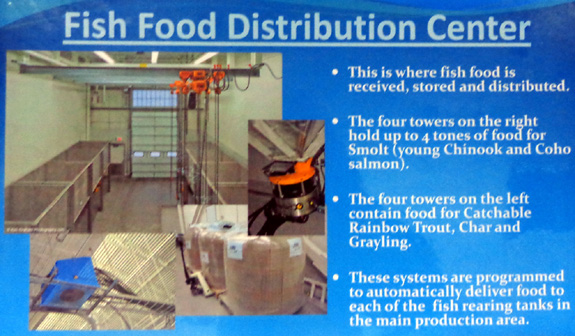
Because the facility is still relatively new, not all of the tanks have
water and fish in them right now.
When the plant is at full capacity it will be able to raise over six
million rainbow trout, king (Chinook) salmon, silver (Coho) salmon,
Arctic grayling, and Arctic char each year. The current production is a
little over four million fingerling, smolt, and catchable fish.
Another interesting area describes how fish eggs are incubated at the
facility:
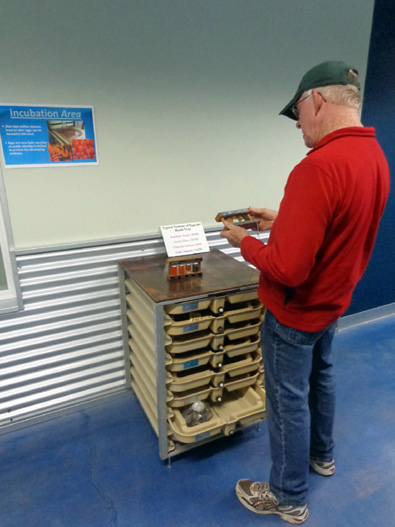
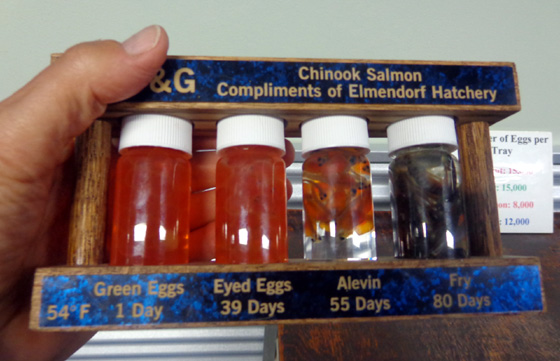
Over two million salmon, trout, or char eggs can be incubated in a
nearby area that visitors don't see because the developing embryos are
extremely light sensitive.
Many of the eggs that
are incubated at this facility come from remote sites in Alaska. To
minimize the transfer of disease from the wild they must be disinfected
before being placed in the incubation system. Signs in this area show
photos of the equipment we couldn't see.
At the far end of the building we went back downstairs and outside to
the fish spawning and viewing area. There are more tanks (raceways)
there and we could see quite a few large, red salmon both in the tanks
and in the creek:
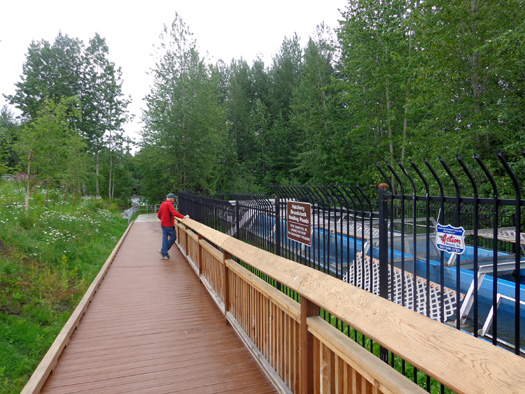
A two-tiered, manmade waterfall prevents some of the salmon from
swimming farther upstream. There is an old fish ladder (wier) at the side:

Downstream from the waterfall we could see salmon in quiet
eddies along the edges of the creek; a sign indicated this is
spawning habitat:
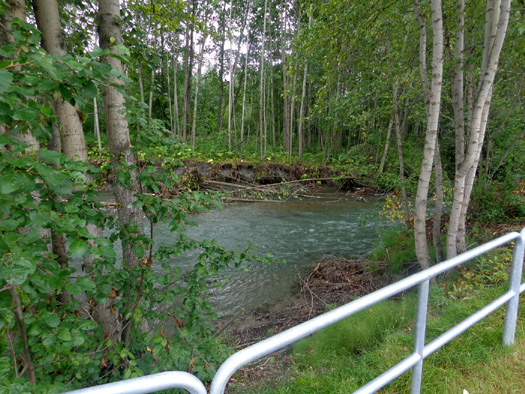
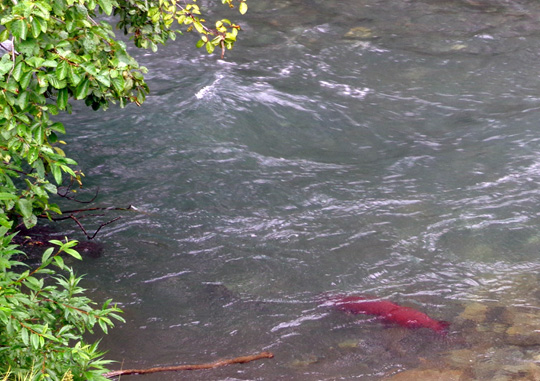
We found this fishery
tour very interesting, even though neither of us fishes.
Go see it if
you're in Anchorage. It's outside the JBER gates so you don't have to go
through security. And it's free!
RELATED SALMON ISSUE
Speaking of salmon, this
article was on the local Channel 2
website today: "Collapsing King Salmon Runs Devastate Kenai
Tourism Economy."
There aren't enough king salmon in the rivers on the Kenai Peninsula
this year for commercial, sport, or subsistence fishermen to catch any of them -- it's
forbidden by the Alaska Fish & Game Department. If enough king salmon
cannot spawn this year, the species could be doomed in this area.
Fortunately, the sockeye salmon run on the peninsula is excellent this year, so folks are
drawn to the area to catch those. It's interesting to read how all this
affects the area's residents and economy.
STATIC AIRCRAFT DISPLAY
On the way back through the Elmendorf side of JBER Jim turned on Sijan
Ave. and showed me a static display of half a dozen aircraft near the
flight line:
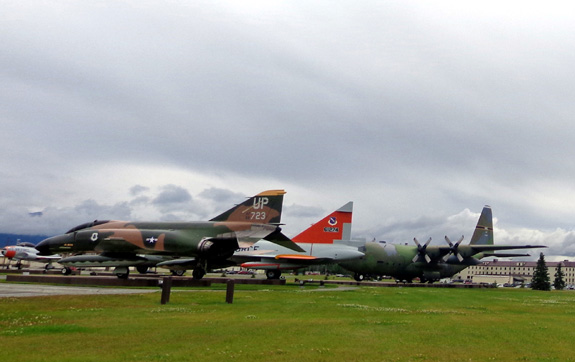
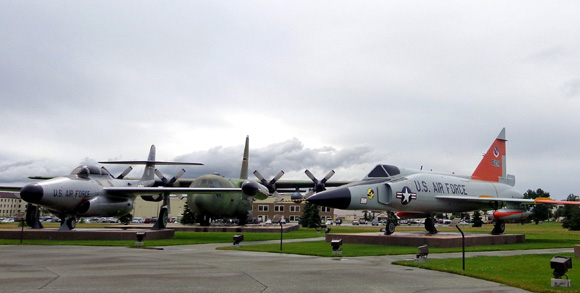
Those were not on our JBER map. Jim found them during a bike ride.
He also had a surprise to show me across the street, something he knew I'd
enjoy more than the planes:
BALD EAGLE DISPLAY
Across the street from the aircraft display is a large fenced and wooden
enclosure with two bald eagles in it:
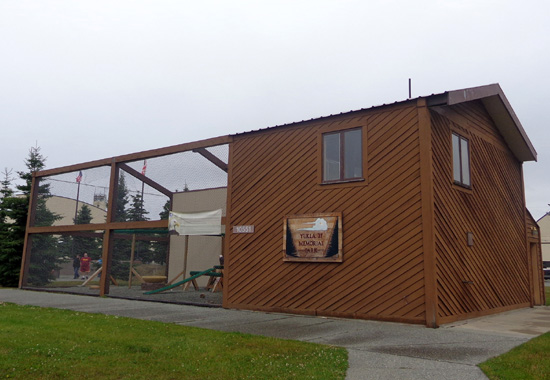
Both eagles were injured and donated to the Air Force Base in the early
1990s because they couldn’t survive in the wild.
It's fitting that
they are housed here. When our founding fathers chose the bald eagle as
our national symbol 'way back in 1782 they noted that it represents "a
free spirit, high soaring and courageous."
That sure sounds to
me like the brave and daring men and women who serve in our Air Force.
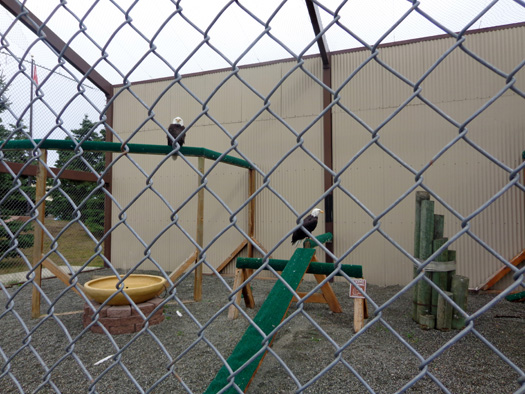
The brown sign in the lower right says "Reserved Parking: Handicapped
Eagle."
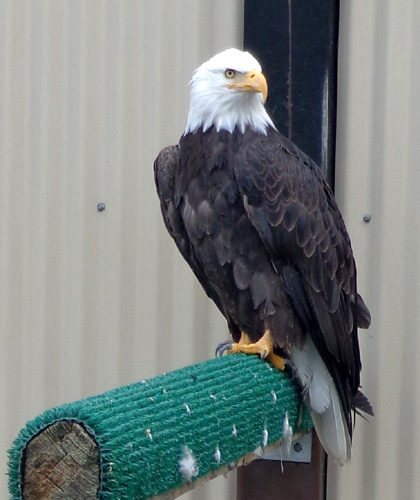
"Jack" is missing his left eye and has an old wing
injury that prevents flight.
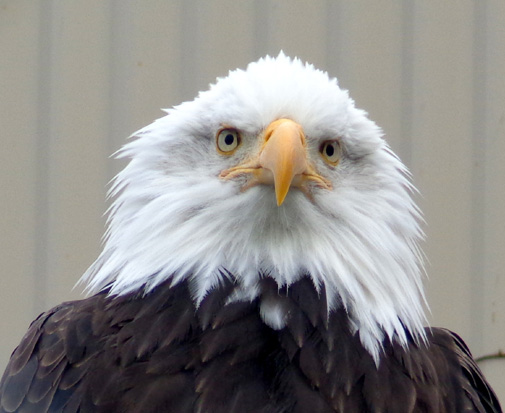
"Notch" has limited
flight ability after a gunshot wound. Isn't he handsome?
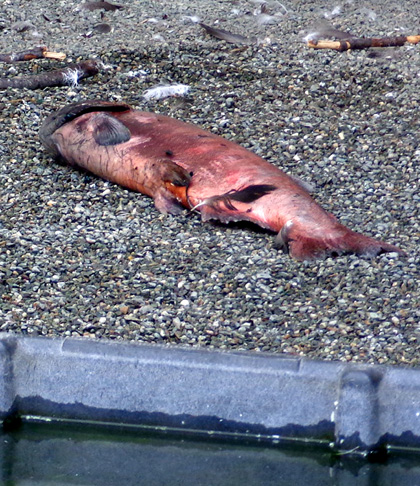
I noticed this partially-eaten salmon in their
enclosure . . .
Visitors must go through security at one of the JBER gates to see the
aircraft and/or eagle display but it's not a big deal if you have valid
ID and vehicle registration.
After supper we watched the DVD of the movie, "The Curious Case of Benjamin
Button” with Brad Pitt and Cate Blanchett. It’s the story of a man
who is born in his 80s and ages backwards to birth. It is a good
reminder that you’re as young as you think and feel, not just how you
look.
Tomorrow looks like the only day with a good
chance of sunshine for the next week so we've planned more cycling and
hiking then.
Next entry: my 14-mile hike with Cody on the Gold Mint Trail off
Hatcher Pass Road
Happy trails,
Sue
"Runtrails & Company" - Sue Norwood, Jim O'Neil,
and Cody the ultra Lab
Previous
Next
© 2012 Sue Norwood and Jim O'Neil


























